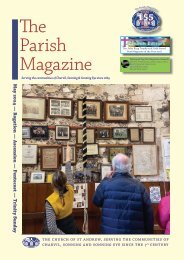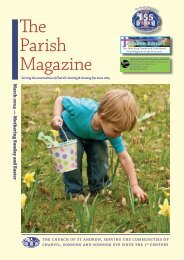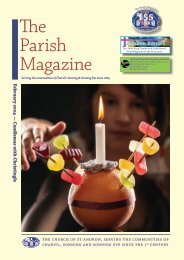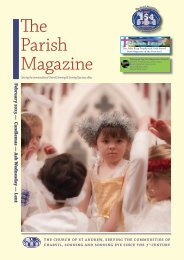The Parish Magazine November 2020
Serving the communities of Charvil, Sonning and Sonning Eye since 1869
Serving the communities of Charvil, Sonning and Sonning Eye since 1869
You also want an ePaper? Increase the reach of your titles
YUMPU automatically turns print PDFs into web optimized ePapers that Google loves.
HOME & GARDEN
In the garden
The Parish Magazine - November 2020 39
Recipe of the month
By Kirsty Steele
Despite the changing seasons, there is at least one plant
that is in full bloom at this time of year. Not spectacular
to look at, yet ivy is an important source of nectar for
bees, moths, flies and wasps, and while they are not most
people's favourite insects, they all play a vital part in
Nature's jigsaw.
Ivy produces flowers from September to November.
Spherical clusters of greeny-yellow blobs, which on closer
inspection have endearing little horns with knobs on!
The resulting fruits are dark berries with ridged sections,
resembling tiny black footballs each containing five seeds.
Poisonous for us, but birds love them.
Ivy is one of the few native climbing plants that can
reach a substantial size. Contrary to popular belief, it is
not a parasite. Its stems have lots of fibrous, adhesivecovered
roots which cling to buildings, brickwork, trees,
telegraph poles, in fact just about anything to help it gain
some height.
NOURISHINGLY USEFUL
Picture: Pixabay.com
Never underestimate ivy
However, when it comes to nourishment, that comes
via the roots in the ground — there's not much nutritional
value in a brick. Although ivy does not normally damage
sound buildings or walls, and is rarely a threat to healthy
trees, its weight can cause problems.
What a useful plant it can be! Providing shelter,
hibernation and nesting sites for birds and insects, its
glossy green leaves are happily munched by sheep, goats
and deer. These leaves, so familiar, are different shapes
according to whether they are on flowering or growing
branches.
The flowers are surrounded by heart, or spear shaped
leaves, while the rest of the plant has the three or five
pointed ones we all recognise.
Many legends involve ivy. But has anyone discovered
why although mentioned in the first line of the carol The
Holly and the Ivy, it is absent from the rest of the verses?
Malva Pudding
From Emma's Kitchen
Malva Pudding originated in South Africa. It became
popular there during the 1980's and remains a firm
favourite today.
Ingredients — Serves 6
Pudding
— 250g sugar
— 2 eggs
— 30ml apricot jam
— 30g butter
— 5ml vinegar
— 125ml milk
— 310g all purpose flour
— 5g bicarbonate of soda
— Pinch of salt
Sauce
— 250ml cream
— 125g butter
— 125g brown sugar
— 125ml water
— 5ml vanilla essence
— 30g golden syrup
Method
Heat the oven to 180°C
Beat the eggs and sugar together until light and fluffy
In a small pan melt the butter, add the milk and vinegar
—it will curdle, don't worry.
In a separate large bowl, sift together the flour,
bicarbonate and salt.
Slowly add to the egg mixture, alternating with the milk
mixture.
Mix until all ingredients are combined together.
Pour into a large 2 litre oven proof dish and bake at 180°C
for 45 minutes until the top if browned.
For the sauce bring the butter, cream, sugar and water to
the boil and then simmer. Add the vanilla essence and
golden syrup, stirring constantly for 5 minutes.
Pour over the hot pudding.
Serve immediately with either custard, cream or ice
cream.
NOVEMBER 2020.indd 39 11/10/2020 23:50:31


















